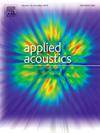轨道腹板中超声尾随脉冲的产生与传播研究
IF 3.4
2区 物理与天体物理
Q1 ACOUSTICS
引用次数: 0
摘要
超声形态特征对钢轨脉冲回波检测有重要影响。具体来说,钢轨是一个复杂的波导,钢轨头、钢轨腹板和钢轨底座在尺寸上有很大的不同。随着厚度与波长比的变化,超声形态在体波、尾波和导波之间演化。其中,尾随脉冲是体波和导波之间的过渡状态,表现为一系列在时域上几乎无色散且均匀分布的脉冲。从几何声学和瑞利-兰姆函数的角度,分析了轨道腹板中尾随脉冲的产生机理,求解了相邻脉冲之间的时间差。利用有限元方法模拟了超声波从轨头向轨腹板传播过程中在结构边界处的反射和折射,展示了拖尾脉冲的产生过程。钢轨表面和腹板截面的实验结果验证了理论模型,脉冲时间间隔误差小于2%。本文章由计算机程序翻译,如有差异,请以英文原文为准。
Study of generation and propagation of ultrasonic trailing pulses in rail web
The morphological characters of ultrasound influence the pulse-echo inspection of steel rails significantly. Specifically, the steel rail is a complex waveguide, with the rail head, rail web, and rail base are quite different in their dimensions. As the thickness to wavelength ratio changes, the ultrasonic morphology evolves between bulk waves, trailing pulses, and guided waves. Among them, the trailing pulses are a transition regime between bulk waves and guided waves, manifested as a series of pulses which are nearly non-dispersive and equally-distributed in time domain. From the perspective of geometric acoustics and Rayleigh-Lamb function, the mechanism for the generation of trailing pulses in the rail web is analyzed, the time difference between adjacent pulses is solved. The finite element method is then applied to simulate the reflection and refraction of ultrasonic waves at the structural boundaries as they propagating from the rail head to the rail web, demonstrating the generation process of trailing pulses. Experimental results from rail surface and web cross-section validate the theoretical model, showing less than 2% error in pulse time intervals.
求助全文
通过发布文献求助,成功后即可免费获取论文全文。
去求助
来源期刊

Applied Acoustics
物理-声学
CiteScore
7.40
自引率
11.80%
发文量
618
审稿时长
7.5 months
期刊介绍:
Since its launch in 1968, Applied Acoustics has been publishing high quality research papers providing state-of-the-art coverage of research findings for engineers and scientists involved in applications of acoustics in the widest sense.
Applied Acoustics looks not only at recent developments in the understanding of acoustics but also at ways of exploiting that understanding. The Journal aims to encourage the exchange of practical experience through publication and in so doing creates a fund of technological information that can be used for solving related problems. The presentation of information in graphical or tabular form is especially encouraged. If a report of a mathematical development is a necessary part of a paper it is important to ensure that it is there only as an integral part of a practical solution to a problem and is supported by data. Applied Acoustics encourages the exchange of practical experience in the following ways: • Complete Papers • Short Technical Notes • Review Articles; and thereby provides a wealth of technological information that can be used to solve related problems.
Manuscripts that address all fields of applications of acoustics ranging from medicine and NDT to the environment and buildings are welcome.
 求助内容:
求助内容: 应助结果提醒方式:
应助结果提醒方式:


